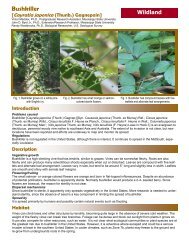RATopic1_95 - Geosystems Research Institute - Mississippi State ...
RATopic1_95 - Geosystems Research Institute - Mississippi State ...
RATopic1_95 - Geosystems Research Institute - Mississippi State ...
Create successful ePaper yourself
Turn your PDF publications into a flip-book with our unique Google optimized e-Paper software.
issues regarding the recent discovery of cactus moth in southern Louisiana<br />
and potential future strategies. The meeting was by invitation only,<br />
and attendees participating represented Barataria Terrebonne National Estuary<br />
Program, MSU-GRI, National Park Service (Arizona), SAGARPA<br />
(Mexico), Southeastern Louisiana University, Texas A&M University,<br />
The Nature Conservancy, USDA-APHIS, USDA-ARS, and USDA-PPQ.<br />
The first day included an on-site inspection of the infested area in the Louisiana<br />
marsh (Figure 2). The remainder of the meeting was a facilitated,<br />
roundtable meeting, where after two intense days of discussion the group<br />
generated 5 strategic plans. Each plan represented a different level of activity<br />
intensity and addressed the positive and negative sides of each plan.<br />
These plans will be utilized by USDA for near-future decision-making in<br />
regard to cactus moth.<br />
John Madsen participated in the National Biological Information Infrastructure<br />
conference on content, the first such conference since 2005. The<br />
Conference was held 3-5 February 2009 in Baltimore, MD.<br />
John Madsen attended the 10 th National Invasive Weeds Awareness<br />
Week (NIWAW 10), February 22-27, 2009, in Washington, DC, and presented<br />
a poster on the MSU/USGS/NBII collaboration.<br />
Figure 3. John Madsen sampling posttreatment<br />
biomass on the Noxon Reservoir,<br />
Montana, in September 2009. Photo<br />
by Celestine Duncan.<br />
John Madsen represented the Weed Science Society of America on the<br />
National Invasive Species Awareness Week organizing committee. The<br />
first NISAW meeting was held January 11-14 2010, but the organizing<br />
committee met monthly by teleconference from February 2009 to January<br />
2010.<br />
John Madsen, Victor Maddox, and Richard Brown cooperated with the <strong>Mississippi</strong> Department of Agriculture on<br />
invasive species issues as part of the Cooperative Agricultural Pest Survey, a program of USDA APHIS.<br />
John Madsen, Victor Maddox, and Gary Ervin have participated in the new <strong>Mississippi</strong> Cooperative Weed Management<br />
Area program. Victor has been selected to be the new coordinator, on a part-time contract with MSU GRI.<br />
John Madsen, Ryan Wersal and Michael<br />
Cox have been working with the Pearl River<br />
Valley Water Supply District to monitor<br />
invasive plants and assess management on<br />
the Ross Barnett Reservoir near Jackson,<br />
MS.<br />
John Madsen and Ryan Wersal worked<br />
with Kurt Getsinger of the US Army Engineer<br />
<strong>Research</strong> and Development Center on a<br />
demonstration project to control Eurasian<br />
watermilfoil in the Noxon Reservoir, Montana<br />
(Figure 3).<br />
John Madsen and Ryan Wersal participated<br />
with Angela Poovey of the US Army Engineer<br />
<strong>Research</strong> and Development Center on a<br />
ring test for macrophyte aquatic toxicology,<br />
under the Aquatic Macrophyte Ecotoxicology<br />
Group of the Society for Environmental<br />
Toxicology and Chemistry (SETAC).<br />
Figure 4. Laura Varone (left) and Guillermo Logarzo (right), both of USDA<br />
ARS, Buenos Aires, checking out <strong>Mississippi</strong> pitcher plants (Sarracenia<br />
alata) at Sandhill Crane NWR.<br />
2009 USGS Annual Report 33 <strong>Mississippi</strong> <strong>State</strong> University’s <strong>Geosystems</strong> <strong>Research</strong> <strong>Institute</strong>




